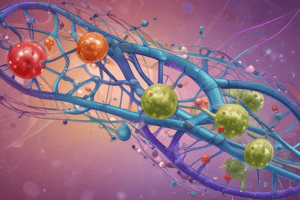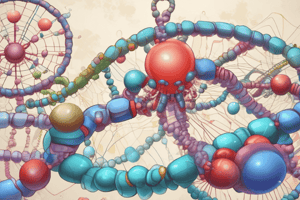Podcast
Questions and Answers
What can result from injecting a nucleus from an adult skin cell into an enucleated egg?
What can result from injecting a nucleus from an adult skin cell into an enucleated egg?
- Immediate cell death
- Formation of a different type of cell
- No development at all
- A normal embryo and subsequently a tadpole (correct)
Which gene products are typically continuously expressed in most cells?
Which gene products are typically continuously expressed in most cells?
- Constitutive genes (correct)
- Inducible genes
- Repressible genes
- Regulated genes
Which subunit of the E. coli RNA polymerase is involved in the initiation of transcription?
Which subunit of the E. coli RNA polymerase is involved in the initiation of transcription?
- β
- σ (correct)
- β'
- α
How does a repressor protein impede the access of RNA polymerase to its promoter?
How does a repressor protein impede the access of RNA polymerase to its promoter?
Which region interacts with the σ factor of RNA polymerase in bacterial promoters?
Which region interacts with the σ factor of RNA polymerase in bacterial promoters?
Which genes are synthesized only under specific environmental conditions?
Which genes are synthesized only under specific environmental conditions?
Which subunit of E. coli RNA polymerase binds to the DNA template?
Which subunit of E. coli RNA polymerase binds to the DNA template?
Which method involves using activators to increase the affinity of RNA polymerase for a promoter?
Which method involves using activators to increase the affinity of RNA polymerase for a promoter?
What is the function of the α subunit in E. coli RNA polymerase?
What is the function of the α subunit in E. coli RNA polymerase?
What allows the coordinated expression of different sets of genes in bacteria?
What allows the coordinated expression of different sets of genes in bacteria?
Which of the following statements is true about positive control mechanisms?
Which of the following statements is true about positive control mechanisms?
What causes the dissociation of the regulatory protein from DNA in Positive Regulation - I?
What causes the dissociation of the regulatory protein from DNA in Positive Regulation - I?
Which binding site is NOT included in a bacterial operon?
Which binding site is NOT included in a bacterial operon?
In which regulatory mechanism does the molecular signal cause binding of the regulatory protein to DNA?
In which regulatory mechanism does the molecular signal cause binding of the regulatory protein to DNA?
Which feature is essential for a bacterial operon to function correctly?
Which feature is essential for a bacterial operon to function correctly?
How are the genes in a bacterial operon typically transcribed?
How are the genes in a bacterial operon typically transcribed?
Study Notes
Gene Regulation Mechanisms
- Regulator genes encode products that regulate the expression of other genes.
- Positive control mechanisms require the product of the regulator gene (activator) to turn on the expression of structural genes.
- Negative control mechanisms require the product of the regulator gene (repressor) to shut off the expression of structural genes.
Negative Regulation
- Molecular signal causes binding of regulatory protein to DNA.
- Bound repressor inhibits transcription.
Positive Regulation
- Molecular signal causes dissociation of regulatory protein from DNA.
- Bound activator facilitates transcription.
Bacterial Operon
- Consists of activator binding site, repressor binding site (operator), promoter, and regulatory sequences.
- Genes transcribed as a unit (polycistronic mRNA) and translated into multiple proteins.
Gene Regulation and Expression
- Nucleus from an adult skin cell can be injected into an enucleated egg to produce a normal embryo and tadpole.
- Many stages of gene expression can be regulated, and the rate of each can be changed.
Constitutive Genes
- Essential for almost all living cells.
- Continuously expressed in most cells.
- Perform "housekeeping" functions.
- Examples include genes involved in protein synthesis, such as ribosomal RNA, transfer RNA, and RNA polymerase subunits.
Inducible and Repressible Genes
- Only needed under certain environmental conditions.
- Synthesis controlled by regulatory mechanisms.
- Examples include alcohol dehydrogenase, which is only made when ethanol is present.
E. coli RNA Polymerase
- Core enzyme composed of α, β, β', and ω subunits.
- Holoenzyme has an additional σ subunit.
- Subunit functions:
- α: Assembly of the tetrameric core.
- β: Ribonucleoside triphosphate binding site.
- β': DNA template binding region.
- σ: Initiation of transcription.
Regulation at Transcription Initiation
- Three main ways to regulate transcription initiation:
- Alter specificity of RNA polymerase-promoter interaction.
- Impede access of RNA polymerase to its promoter.
- Use of activators to enhance polymerase-promoter activity.
DNA Sequences Involved in Regulation of Gene Expression
- Bacterial promoters include conserved -10 region (Pribnow box) and -35 region.
- These regions interact with the σ factor of RNA polymerase.
- Some promoters also include the upstream element, which interacts with the α subunit of RNA polymerase.
Two Main Mechanisms to Regulate Transcription in Bacteria
- Use of different σ factors in RNA polymerase.
- Binding of other proteins, transcription factors, to promoters.
Studying That Suits You
Use AI to generate personalized quizzes and flashcards to suit your learning preferences.
Description
Learn about the role of regulator genes in controlling gene expression through positive and negative control mechanisms, including activators and repressors.




